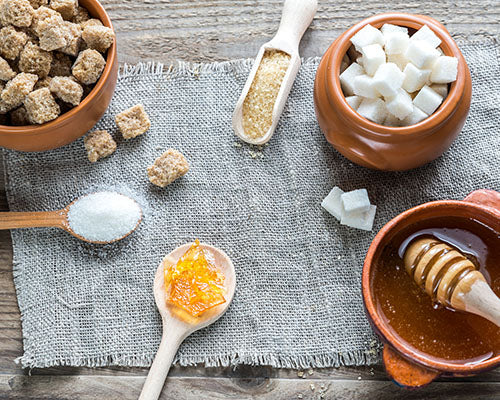Honey vs. Sugar
When you brew a cup of hot tea, do you reach for honey or sugar? Although both may add sweetness to your drink, their nutritional benefits vary.
Honey and sugar are both carbohydrates composed primarily of glucose and fructose. They’re used as ingredients in many packaged foods and recipes. Both can contribute to weight gain if overused.
Honey’s reputation for being healthier may have some basis, but honey isn’t considered a health food. So, which sweetener is healthier? Here’s what you need to know:
Honey Basics
Bees use the nectar they collect from flowers to create honey. This thick substance is typically consumed in liquid form and can range in color from pale yellow to dark brown.
Honey is composed primarily of water and two sugars: fructose and glucose. It also contains trace amounts of:
- • Amino acids
- • Antioxidants
- • B vitamins
- • Enzymes
- • Minerals
- • Vitamin C
Many of the antioxidants found in honey are classified as flavonoids. Flavonoids have anti-inflammatory properties, which may provide some health benefits. The exact nutritional makeup of honey varies based on its origin. There are more than 300 varieties of honey, including:
- • Alfalfa
- • Eucalyptus
- • Golden blossom
- • Tupelo
- • Wildflower
Each variety of honey has a distinct color and flavor. For example, buckwheat honey is a popular dark honey known for its malty taste. Fireweed honey is a light variety that’s nearly translucent in color and has a tea-like flavor.
No matter which type you prefer, any kind of honey can spike blood sugar levels.
What Are The Benefits Of Honey?
Honey is higher in fructose than glucose. Fructose is sweeter than glucose, so you may be able to use a smaller amount of honey in your food or drink without sacrificing sweetness.
The trace amounts of vitamins and minerals found in honey may also have added health benefits. However, these amounts are extremely small.
Raw, unpasteurized honey contains trace amounts of local pollen, which may help desensitize allergic reactions.
Honey also provides additional health benefits:
- • It may help kill off germs because it has antimicrobial properties
- • When used as a salve in gel form, it may help promote healing of wounds and minor burns.
- • It may help ease coughing and sore throats.
Overall, honey goes through less processing than sugar does. To become table-ready, it requires pasteurization only. Honey can also be eaten raw.
Are There Downsides To Honey?
At around 22 calories per teaspoon, honey is slightly higher in calories than sucrose. It consists primarily of sugar and should be used sparingly. This is especially true if you have health concerns such as diabetes, heart disease, or obesity.
Honey may be dangerous for infants younger than a year. This is because it contains bacterial spores that can cause botulism in infants.
Additionally, honey’s stickiness may make it a messy choice for households with small children.
Sugar Basics
Sugar is made up of a combination of glucose and fructose, which bond together to form sucrose. It has no added vitamins or nutrients.
A calorie-dense carbohydrate, sugar is derived from sugar beet and sugar cane plants. It requires multistep processing before it becomes the refined, granulated table sugar that we use most often.
Of the many types of sugar, white, brown, and raw sugar are the most commonly used.
Brown sugar is a combination of white sugar and molasses and may have some trace nutrients. It’s used primarily in baking.
Raw sugar is a less refined version of white sugar. It is light brown and contains larger crystals. Raw sugar doesn’t vary nutritionally from white sugar.
Other types of sugar include powdered, turbinado, and muscovado sugar.
What Are The Benefits Of Sugar?
As a carbohydrate, sugar is a potential source of fast fuel. Your brain needs 130 grams of carbohydrate daily to function. This naturally occurring substance is also low in calories, with a
teaspoon containing about 16 calories.
White sugar has a long shelf life and is easy to use in baking and cooking. Sugar is typically low cost and easily accessible.
Are There Downsides To Sugar?
Eating too much sugar can increase your risk of heart disease and type 2 diabetes. Sugar is a common ingredient in many processed foods, so you may eat more of it than you realize. This can lead to weight gain and obesity.
People with diabetes should be mindful of their sugar consumption, as it can cause blood sugar to spike. If consumed in quantities greater than your body needs, sugar can provide a quick burst of fuel followed by a sharp drop in energy.





